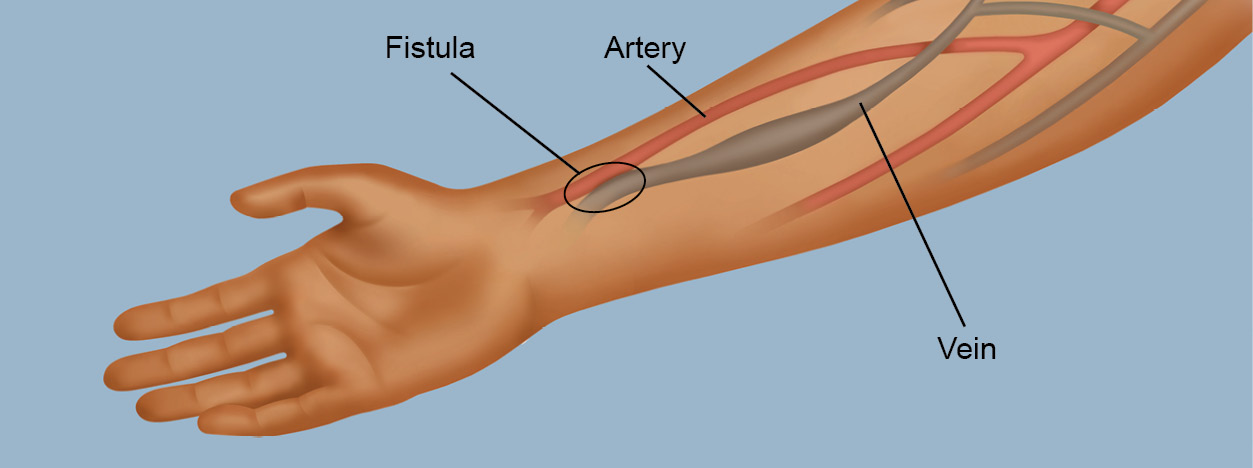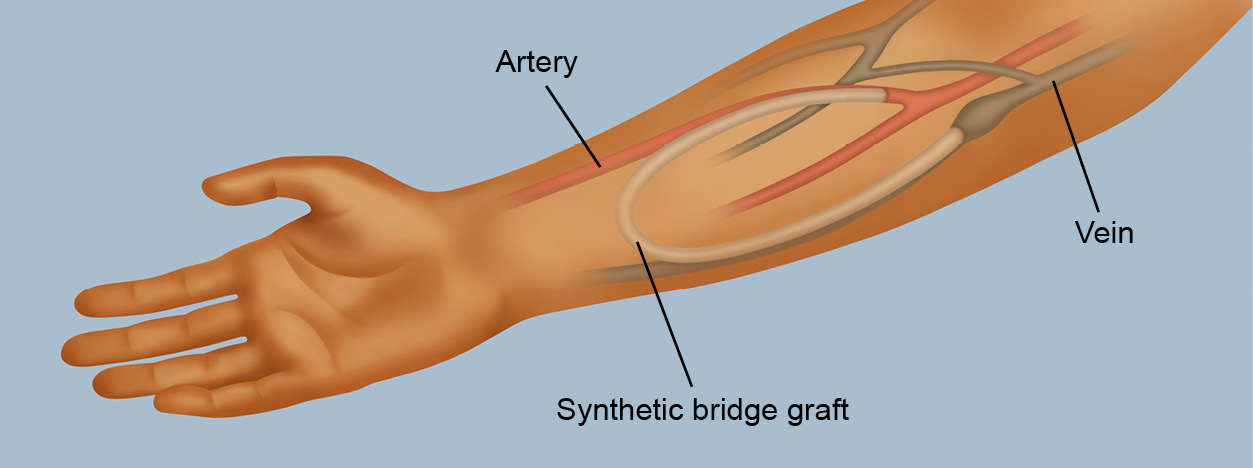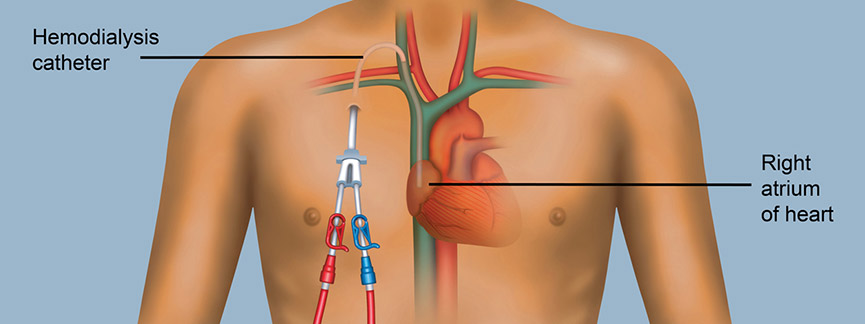Types of Vascular Access for Hemodialysis
Your hemodialysis access, sometimes known as a vascular access, is your lifeline during hemodialysis treatment. During hemodialysis, your access allows blood to safely leave your body through soft tubing and travel to the artificial kidney or dialyzer to be cleaned. Once your blood has been filtered through the dialysis machine, it is safely returned to your body through your access site. When making a treatment plan, you’ll want to make sure you have the safest, most effective type of access for you—and that you care for it properly.
A hemodialysis access is necessary for both in-center hemodialysis and home hemodialysis, and when it comes to your treatment plan, it’s important to understand your options. If you have any questions about which hemodialysis access is right for you, talk to your care team for more information.
3 types of hemodialysis access sites
There are 3 types of hemodialysis access sites:
- Fistula
- Graft
- Hemodialysis catheter
Depending on your health, the strength of your veins, and other factors, you and your doctor can decide which type of access is best for you. Hemodialysis is different than peritoneal dialysis, so it’s important to note that each have different types of access sites.
When you have stage 4 or stage 5 chronic kidney disease, it’s important to plan ahead to protect your remaining kidney health and feel your best. You will need to schedule your access surgery for fistulas or grafts in advance of your dialysis treatments. These are considered minor surgeries and are usually done on an outpatient basis. If you have already started your hemodialysis treatment and have a catheter, it is still important to have surgery for a fistula or graft. Hemodialysis catheters are generally not recommended for the long term because they provide a slower rate of blood flow and have a higher risk of infection and blood clots.

AV fistula for hemodialysis
- An arteriovenous (AV) fistula is considered the best choice for hemodialysis—it is made with your own blood vessels, provides optimal blood flow, and has the lowest chance of infection.
- To create an AV fistula, sometimes known as a hemodialysis fistula, a surgeon connects one of your arteries to a vein—under the skin of your upper arm or forearm.
- An AV fistula access takes 6-8 weeks to heal—and if possible, it should be placed at least 2-3 months before you begin dialysis to allow time for it to develop and mature. Your doctor will recommend appropriate timing.
- To see if you are a candidate for an AV fistula, vein mapping is an important first step—this painless, noninvasive ultrasound test helps your doctor assess the condition of your veins and determine if a fistula is the best option for you.
- If you are unable to have surgery for an arteriovenous fistula before you begin treatment—it is still possible to do so after your treatment has begun. It is especially recommended if you have had to opt for a hemodialysis catheter, which is often used as a temporary access solution until a graft or fistula is ready.
- During treatment, a nurse places 2 needles into the fistula in a process called cannulation—these needles are connected to tubing that leads to and from the dialysis machine. During dialysis, your blood flows out of your body through one needle that is connected to your artery, the arterial needle, and into the dialysis machine. After your blood is filtered, it returns to your body through the other needle, the venous needle, which is connected to your vein.

AV graft for hemodialysis
- An arteriovenous (AV) graft is an access site—formed by a soft tube that connects a vein and an artery in your arm.
- To create an AV graft, a surgeon connects your artery to a piece of soft tubing that acts like a vein—it’s placed under the skin of your upper arm or forearm.
- An AV graft takes 2-3 weeks to heal—make sure you talk to your care team about planning your access surgery ahead of time so you'll be ready for dialysis treatment.
- An AV graft is a great access alternative for people who have small or weak veins that may have trouble developing into a fistula—or people who show signs of stenosis—the narrowing of blood vessels that could lead to decreased blood flow or clotting. Your care team will be able to help you decide on the best type of access for you and develop an access plan.
- Veins can sometimes get larger or stronger with time on dialysis—so if your graft fails, your doctor may be able to reconsider a fistula or a new graft in a different location.
- Receiving treatment through an AV graft requires the same cannulation process as an AV fistula—a nurse places 2 needles into the graft, which are connected to tubing that leads to and from the dialysis machine. Your blood flows out of your body through one needle and is taken through the dialyzer to be cleaned. Then, the filtered blood is returned safely to your body through the other needle.
Whether you're preparing for dialysis or switching from one dialysis option to another, our Treatment Decision Guide can help you decide what treatment option is best for you.
Caring for your fistula or graft
Whether you choose a graft of fistula as your hemodialysis access site, it’s important to care for it properly. Keeping your hemodialysis access site clean and protected will help you avoid infection—and ensure that your dialysis treatment is as efficient as possible. Your care team will teach you how to care for your particular hemodialysis access type.
There are 3 simple ways to protect your fistula or graft:
- Practice good hygiene—maintaining a good hygiene routine can help keep your access free of infection and irritation. Always sanitize and wash your hands before touching your access, and make sure others do too. Before using your access for hemodialysis treatment, be sure to clean your site, arms, and hands.
- Protect your access site—your access site may be sensitive and will need extra care to ensure it stays healthy. Wear loose clothing or jewelry to prevent pressure on your fistula or graft. Use your other arm to carry heavy objects so you don’t strain the access area.
- Check your access site—carefully inspect the area around your access site regularly and look for any sign of infection—including redness, swelling, drainage, or irritation. For a fistula or graft, good blood flow is important as well, so make sure your hemodialysis access site allows blood to move freely.
Questions? Don’t wait. Contact your care team immediately if you notice any of the signs of infection described above while checking your access site.

Hemodialysis catheter
- Most of the time, a hemodialysis catheter, sometimes known as a central venous catheter or a venous catheter, is not a permanent solution—it is used for vascular access only until a fistula or graft is ready.
- A hemodialysis catheter is inserted by a kidney doctor (nephrologist) or surgeon, and requires a scheduled vascular surgery—a hemodialysis catheter is a long Y-shaped tube that is tunneled under the skin and placed in your neck, chest, or groin. The hemodialysis catheter is connected to a central vein, and the other end of the hemodialysis catheter tubing exits your skin and attaches to the tubing on the dialysis machine.
- A hemodialysis catheter can be used immediately—you’ll be ready for hemodialysis right after placement.
- Hemodialysis catheters have a higher risk of clotting and infection and provide a slower blood-flow rate—they are not recommended for the long term.
- If you get a hemodialysis catheter because your blood vessels are not strong enough for a fistula or graft—you may be able to switch to a different access type if your veins get stronger over time.
Caring for your hemodialysis catheter
If your doctor recommends a hemodialysis catheter as a temporary access site, or because it’s medically necessary, it's important to know how to care for it properly to avoid infection and ensure effective dialysis treatment. To help make sure your hemodialysis catheter site stays clean and healthy, keep the following tips in mind:
- Keep your hemodialysis catheter clean and dry.
- Check for any redness, drainage, tenderness or swelling before each treatment.
- Ask your care team before using powder, lotion, or creams on your hemodialysis access site.
- Avoid touching the catheter where it goes into the skin.
- Use proper hand hygiene any time you touch your hemodialysis catheter or the catheter dressing.
- Wear clean, loose-fitting clothing around your catheter and be careful when using zippers.
- Keep the ends of your catheter capped and clamped for your safety.
e-newsletter
Get the latest news in kidney care and delicious kidney-friendly recipes, plus inspiring stories from people living with kidney disease.

